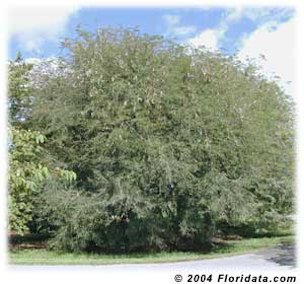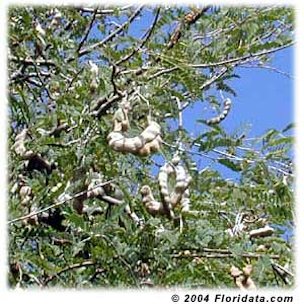Tamarindus indica
Common Name: tamarind
Family: Fabaceae, bean Family
DescriptionThe
tamarind is a large tropical tree with a short massive trunk, ferny
pinnate leaves, small yellow flowers and fat reddish brown pods. The
tree can get 90 ft (27.4 m) tall but is usually less than 50 ft (15.2
ft). It has a short, stocky trunk, drooping branches and a domed
umbrella shaped crown about as wide as the tree's height. The leaves
are about 10 in (25.4 cm) long with 10-18 pairs of 1 in (2.5 cm) oblong
leaflets. Tamarind drops its leaves in pronounced dry seasons; in
climates without a dry season it stays evergreen. The flowers are about
1 in (2.5 cm) across, pale yellow with purple or red veins. They have
five unequal lobes and borne in small drooping clusters. The velvety
cinnamon brown pods are 2-6 in (5.1-15.2 cm) long, sausage shaped and
constricted between the seeds. The pulp that surrounds the 8-10 seeds
is both sweet and extremely sour. The
tamarind is a tender tree for the tropics and The
tamarind is a tender tree for the tropics and
sub-tropics. You can
visit this individual at the Fruit
and Spice Park in Miami, Florida.LocationTamarind,
Tamarindus indica, is cultivated and has naturalized in the tropics
throughout the world, but probably was originally native to eastern
Africa.CultureTamarind
is a slow growing tree that, once established, needs no attention at
all. It is moderately salt tolerant and can be grown in coastal
locations, back away from the actual beach front.
Light: Full sun.
Moisture: Tamarind needs regular watering. It is fairly tolerant of drought, but will drop its leaves during even normal dry seasons.
Hardiness: USDA Zones 10 - 11.
Propagation: Tamarind is generally propagated by seed, but it also can be started from cuttings. Tamarind pods contain a treasure of tasty pulp that Tamarind pods contain a treasure of tasty pulp that
is used in cooking and herbal medicine. UsageTamarinds
are grown as ornamental shade and street trees, and for the edible
pods. The pods are fed to livestock, and the pulp within the pods is
used to make beverages, curries, chutneys and sauces. Tamarind pulp is
made into a soft drink known as refresco de tamarindo in Latin America,
and tamarinade in Jamaica. It's also the basis of a popular drink in
the Middle East. Tamarind is used extensively in Indian and Southeast
Asian cuisine, and is an important ingredient in Worcestershire sauce.
The juice is used to pickle fish in India. Several medicinal uses of
tamarind are reported in Grieve's A Modern Herbal. The fruit is said to
improve digestion, relieve gas, soothe sore throats, and act as a mild
laxative.The tamarind tree is a beautiful, fine textured tree
and it makes an excellent shade tree in large landscapes. It often is
planted in public parks and as an avenue tree in tropical cities.FeaturesSmall
boys often hawk bags of plump tamarind pods along rural roads in
tropical America. Crack open the thin brittle shells and suck on the
seeds for the sweet, yet very acidic pulp. After a few of these your
mouth will pucker and your teeth will hurt! Fresh, unprocessed
tamarinds are best left for the cows!Tamarind is in the pea and bean family, closely related to, and in the same subfamily as, royal poinciana (Delonix regia) and peacock flower (Cesalpiniaa pulcherrima).
The name, tamarind, is used for several other, unrelated plants that
have acidic fruits. Among these are Australian tamarind (Diploglottis australis); the sweet tamarinds (Inga spp.) and Manila tamarind (Pithecolobium dulce) from South America; and velvet tamarind (Dialium guineense), Spanish tamarind (Vangueria madagascariensis) and the horse tamarinds (Leucaena spp.) from Africa.
Back to
Tamarind Page
|